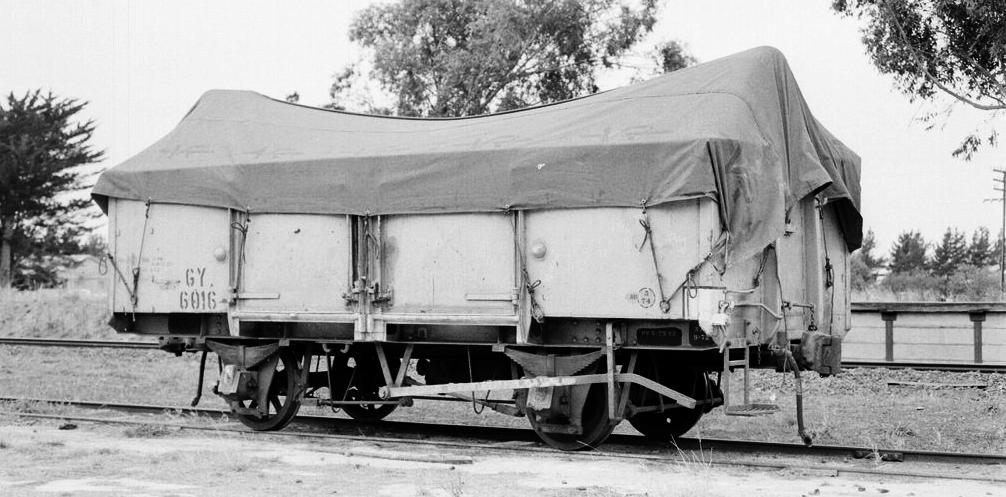

The GY wagon evolved from bogie open wagons coded E, first introduced in 1925. The design is not directly from the E but the heritage is distinct. The design path was _E__ to _IZ_ to _GZ_ to GY to _HY_ to E.
From the E wagon, a four wheel wagon was developed that incorporated similar door widths and axleboxes. The vehicle was classed _IZ_. A grain proofed version was built which was welded and was coded GZ. A reduced capacity truck was required for branchlines that were laid with 60lb/yd rail. The 22ton capacity open wagon coded GY evolved in 1939.
To complete the design cycle, a non grain proof version of the GY was built. The code for this was HY and they were introduced to service in 1948. By the mid 1950's many of the remaining E bogie wagons of rivetted construction were in need of major repair. To rebuild the E wagon, the body was replaced with a welded one which in the main utilised HY components. Thus completed the cycle started in 1927.
Up until 1935 grain was bagged and then moved in standard wagons. The _G__, GZ and GY vehicles in service from then were used for bulk grain; the doors and sides being "grain proof". They were top loaded, tarpaulin covered and at the Geelong Terminal for unloading. In the 1950's unloading was deemed too slow with men and shovels. Mechanical scrapers were used to assist in removing the grain.
Block grain trains of GY's were treated with great respect by train crews as runaways could occur unless care was taken descending long grades.
When not in grain traffic, the vehicles were used for general service: timber, tractors, water tanks or anything that could fit. As there was considerable expense in making the wagons grain proof again for the seasonal wheat traffic, about 1000 wagons were placed into general service only and coded _G__ between 1980 and 1985. This was anticipated by the author as early as 1978 as the number of general class vehicles in service were being drastically cut.
Up to 1948 the GY wagons were painted red with no grain stripe markings. With the introduction of the _HY_, confusion arose with HY wagons being loaded with grain by mistake. From September 1948, the grain wagon classes: G, GY and GZ were marked with a yellow stripe at diagonal corners to denote 'grainproof'.
To assist train visibility in the 1970's, GY wagons started to be painted 'Hansa' yellow from late 1969. By the late 1970's only about one or two GY wagons remained in red scheme.
By the late 1970's, the cost of tarpaulins was becoming prohibitive and the bogie grain fleet had grown to 380 bottom discharge hoppers. To assist the grain handling over 800 of the GY's were drastically modified with bottom discharge hoppers and metal tops. The prototype for these wagons was GY 2207 which became GH 1 after the initial trails in March 1979. The wagons were coded to _GH_ With the introduction of a major construction program of over 300 more bogie vehicles, the GH's were out of service by the 1990's.
The number group for GY's runs 1 - 1160, 2001 - 3149, 3380 - 6149, 15869 - 16129, 16131 - 16722, 16724 - 17030. These numbers break down to three main construction types from several different wagon codes. The wagons number 16130 and 16723 were scrapped prior to the GY conversion program.
These wagons were all built new, either by the railways or by private contractors. They feature lever handbrake, welded body on 'inside' sill ( sill inset under the body). These wagons were placed in service between 1939 and 1948. The numbers between 911 and 2000 were reserved for the GZ number group. Interesting enough, GY 911 was issued to service but renumbered to 2001 shortly after.
The number group 3150 to 3379 were planned for construction by Commonwealth Engineering, NSW in 1943. For unknown reasons the contract was cancelled. Perhaps the influences of WWII and the 'War Production Board' were the reason.
These wagons were converted from _IZ_ and _RY_ wagons from 1965 to 1968. They featured outside sill (sill flush with body) and wheel handbrake. The underframes dated back to 1927.
This wagon was converted from a GZ and was the only GY of inside sill heritage to feature a wheel (transverse) handbrake
These wagons were purchased from the Australian Paper Mills. Twenty wagons were constructed for APM and were private owner. They were coded APM 1 - 20. In 1956 the VR purchased the wagons which were recoded and given the above numbers. The exact renumbering is not known, only the number group involved.
These wagons were built as HY between 1948 and 1958. The HY was a general purpose, non grain proofed wagon. Between 1958 and 1961 the wagons were all grain proofed and recoded to GY.
The number group starts at 15869 because the original vehicles entered service as class IY using the _I__ wagon number group. As IY could apparently be confused with the rivetted type _IY_, existing wagons were recoded and new construction issued with the _IO_ class letters. As 'IO' could be confused with '10' (ten), new stock was issued as _HY_. The IY and IO wagons of this new style were recoded to HY by early 1949.
Vehicles 16130 and 16723 were HY wagons that were scrapped before they could be converted to GY.
GY 2207 ran several loading and discharge tests during March 1979. At completion of the tests, the vehicle was reclassed and renumbered to _GH_ 1.